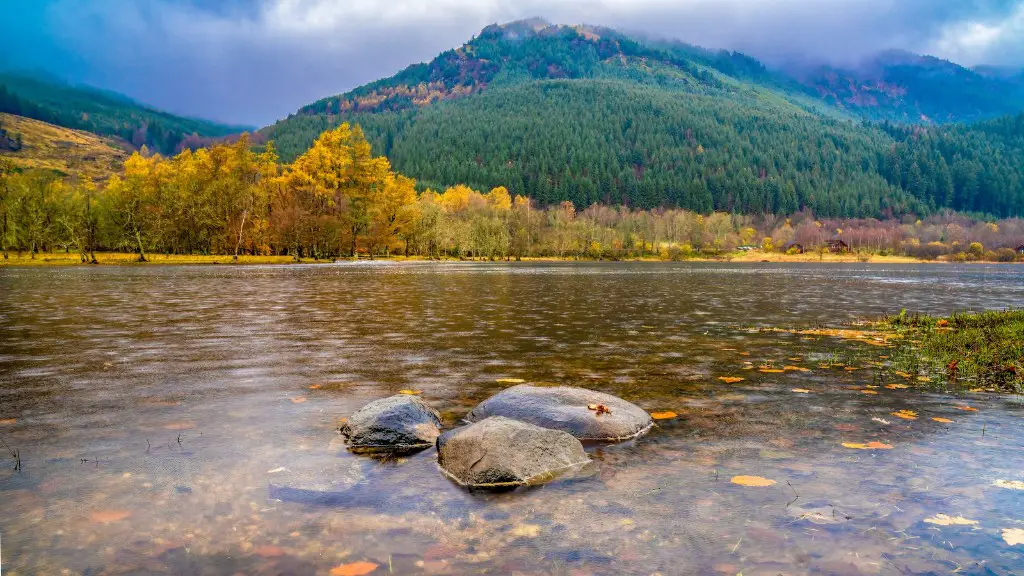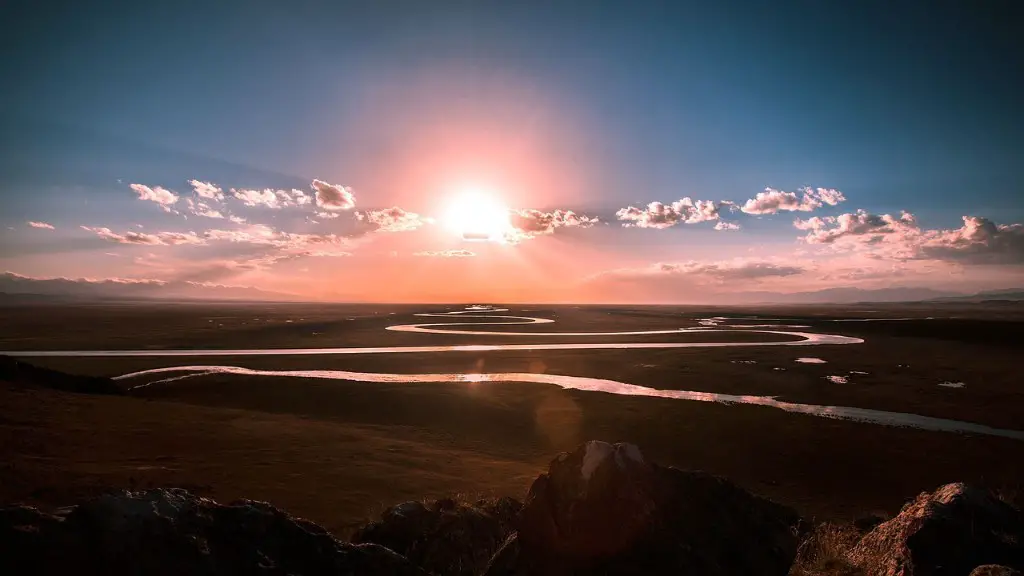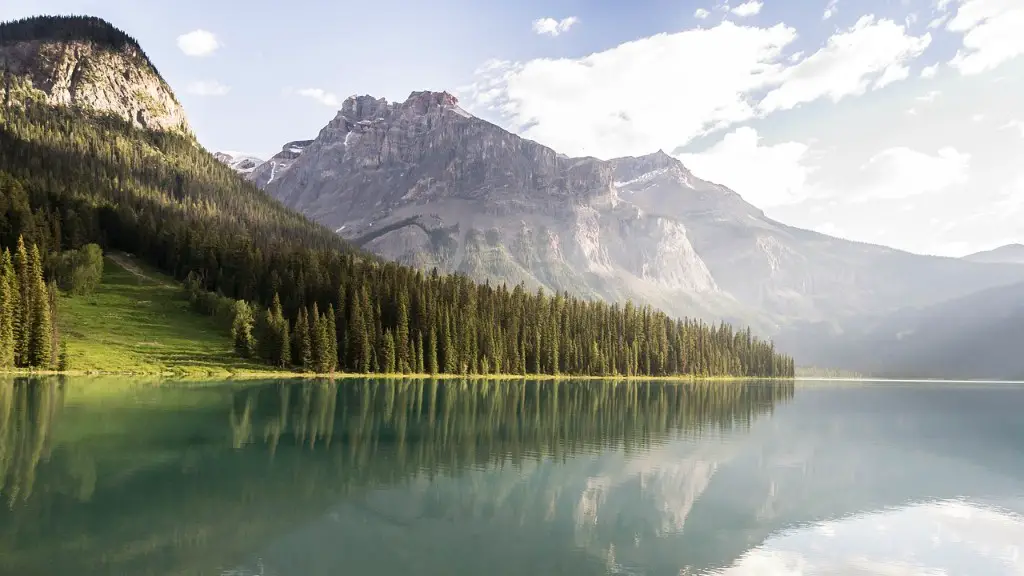The Mississippi River is amongst one of the longest and most historic rivers in the United States. It is entirely within the United States, flowing 2,340 miles from its source in northern Minnesota to the Gulf of Mexico and the Gulf Coast. The origins of the Mississippi River are a mixture of geology and geography, with numerous tributaries and connecting rivers that give the river its famous bends and ends.
The true source of the Mississippi River is located near Itasca State Park, located in northern Minnesota. This is where Lake Itasca, the origin of the Mississippi River, is located. From Lake Itasca, the Mississippi River runs south until it moves further east, winding and turning until it eventually reaches the northern border of Louisiana, where it flows in a more direct route towards the Gulf of Mexico, and then empties into the Gulf of Mexico.
Measuring the area of the Mississippi River basin is a matter of debate. Some experts measure the stretch of the river from the headwaters in Lake Itasca while others include the tributaries and rivers that flow into it, including the Missouri, the Atchafalaya, and other rivers and streams. The river basin, which includes parts of ten states total, is estimated to be between 1,152,460 square miles and 1,363,598 square miles, depending on the definition used.
The impact that the Mississippi River has had on the United States is tremendous. Its length, starting in Minnesota and winding its way across the center of the country to the Gulf of Mexico has seen it play a vital role in the development of the country. From early Native American settlements and transportation, to burgeoning industries in the southern states, the river has been an instrumental part of the American story. During the nation’s westward expansion, the Mississippi acted as an important waterway as white settlers moved into the uncharted territories.
The Mississipi River has also been of great importance to the development of the American economy. The river facilitates trade from the southern states, allowing export of Southern agricultural products, such as soy beans and cotton, to ports along the Gulf Coast. The Mississippi is one of the nation’s most important waterway systems, and provides the U.S. with a number of crucial environmental functions. The traditional use of the river as a major fishing ground and habitat for wildlife has provided jobs, recreation and a recreational resource.
In terms of ecological importance, many refer to the Mississippi River as the “Mother of Waters,” signifying the life-sustaining importance it has on the environment. The robust aquatic life that makes its home in the river, including amphibians, mammals, reptiles, fish, and birds, find their habitat along the slow moving waters.
The Mississippi River Delta is an important ecosystem in the Gulf of Mexico. The delta itself stretches 160,000 square miles, and is classified as an estuary, an arm of the sea that receives both freshwater from rivers and streams and salt water from the gulf. Magnificent in structure and full of life, the delta serves as a home for a variety of flora and fauna, including alligators, pelicans, oysters, and crabs.
Habitats of the Mississippi River
Ranging from the headwaters in the north to the Delta in the south, the Mississippi River provides habitat for numerous species in its northern and southern regions. The cooler waters of the upper Mississippi River support trout, muskellunge and sturgeon, while carp and sheepshead are more commonly found in the more southern waters of the river.
A host of wetland habitats give life to many birds and other small game, while migratory birds and waterfowl also find their way to the river each year. Deer, small mammals, and the occasional bear or fox may also be seen along the banks. Turtles, snakes, frogs and other amphibians can be seen in the marshy riverbanks or along the river basins.
Waterfowl are considered a main species for the Mississippi River basin. Each year, millions of ducks, geese and other water birds travel to the basin in the fall, and then continue to winter along the river from Minnesota to Louisiana, increasing the already diverse range of birds moving and living along the river.
Mineral-rich and supported by an intricate network of water fowl migration that brings thousands of birds to its salty deltas each year, the Mississippi River provides an essential habitat for a wide variety of ecosystems and species.
Impacts and Challenges Facing the Mississippi River
The Mississippi River has had a distinct impact on the country, being integral to the economy, culture, and ecology of many of the states it passes through, but it has also had its fair share of challenges. Today, pollution and environmental degradation are amongst the biggest challenges faced by the River. Nitrogen and phosphorous run off from agricultural land and urban areas have caused harmful algal blooms, leading to fish deaths and water discoloration.
Climate change is also raising concerns. Warmer temperatures are leading to drier summers and higher evaporation rates, meaning that the flow of the Mississippi could become unpredictable. This could affect river transport, water supplies, and the concentration of nitrates and other pollutants downstream.
Overuse of the river can also be hazardous. The Mississippi is currently undergoing water diversion, shipping and intense recreational use more than ever before, which can cause the river to become choked with sediment. This excessive sediment buildup can lead to flooding, displacement of fish and other wildlife, and the destruction of wetlands and aquatic habitats.
The Mississippi River is also subject to regular levee and dam maintenance, as part of efforts to manage flooding and regulate water supply flow. The river’s levees and flood control structures can limit natural processes such as sediment transport, leading to downstream erosion of banks and subaquatic plants.
Economic Benefits of the Mississippi River
The Mississippi River has been a powerful economic engine for the U.S. for centuries. Local industry and businesses of all kinds have relied on and been sustained by the river. Agriculture, shipping and transportation all make use of the river’s resources in some way or another. Tourism is a growing industry along the river – many communities offer different forms of recreation such as sightseeing, fishing and boating.
The Mississippi has also been described as a ‘floating laboratory,’ with many oil and gas exploration projects taking place in the delta. Commercial fishing and aquaculture also take place throughout the Mississippi River Basin, ensuring a steady resource of protein and nutrition to local communities.
The Mississippi River serves as a source of hydropower. There are currently over 260 dams used as hydro-power generators along the river and it is estimated that these hydro power facilities produce 6% of the nation’s electricity needs. This energy is used to power homes and provide jobs for those employed in the operation and maintenance of the dams.
Restoring the Mississippi River
To help restore the Mississippi River and its watersheds, the U.S. has launched several collaborative programs and initiatives. The Mississippi River System Restoration Initiative, launched by the National Fish and Wildlife Foundation, is an example of a collaborative effort to restore and protect the ecological health of the Mississippi River. The program combines resources, research, and science to help develop sustainable strategies for the management of the river and its watersheds.
The National Oceanic and Atmospheric Administration’s (NOAA) sees restoring the river as one of their priorities. Through projects such as wetland restoration and implementation of mitigation measures to reduce sedimentation, the NOAA is helping to ensure the Mississippi River and its delta will continue to provide a sustainable resource.
The Army Corps of Engineers is also involved in restoring the river. Through projects such as improving navigation channels, dams, locks and levees, the Corps helps to achieve the balance between navigation and management of the ecosystem of the Mississippi River.
Conclusion
The Mississippi River is a major source of life, culture and economy for the United States. Despite pollution, flooding and overuse, there are a number of initiatives and programs in place that are helping to restore the river for the people and wildlife that depend on it. By continuing these efforts and protecting the river, we can ensure that the Mississippi will always be a vital and essential part of the United States.





